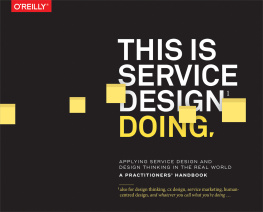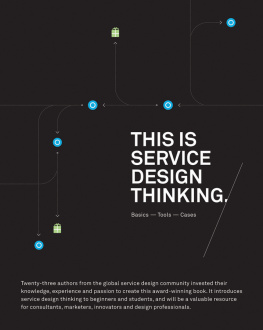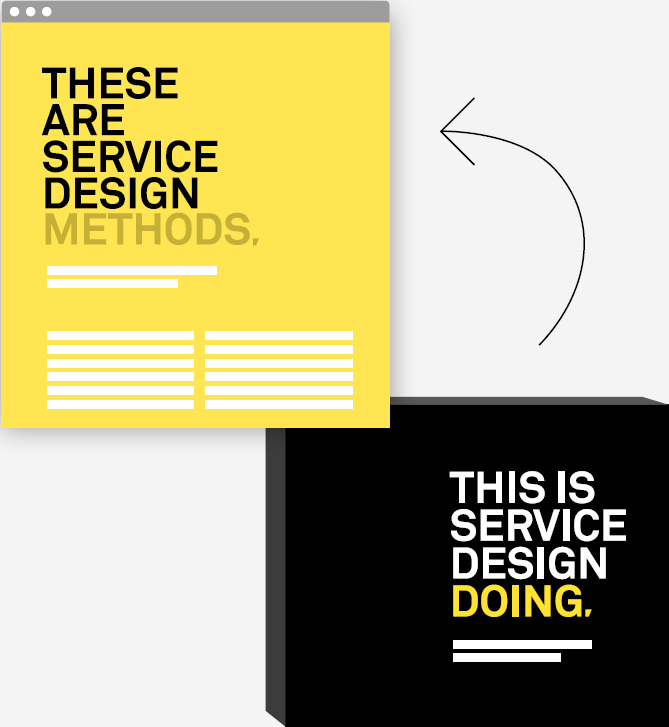THIS IS SERVICE DESIGN DOING
by Marc Stickdorn, Markus Hormess, Adam Lawrence, Jakob Schneider
Copyright 2018 Marc Stickdorn, Markus Hormess, Adam Lawrence. All rights reserved.
Printed in Canada.
Published by OReilly Media, Inc., 1005 Gravenstein Highway North, Sebastopol, CA 95472.
OReilly books may be purchased for educational, business, or sales promotional use. Online editions are also available for most titles (safaribooksonline.com). For more information, contact our corporate/institutional sales department: (800) 998-9938 or corporate@oreilly.com.
Acquisitions Editor: Nick Lombardi
Developmental Editor: Angela Rufino
Production Editor: Melanie Yarbrough
Copyeditor: Jasmine Kwityn
Proofreader: Rachel Head
Indexer: Lucie Haskins
Cover Designer: Jakob Schneider
Interior Designer: Jakob Schneider
Illustrator: Ellie Volkhausen
Compositor: Melanie Yarbrough
Revision History for the First Edition:
2017-11-30 First release
See href="http://oreilly.com/catalog/errata.csp?isbn=0636920040354">http://oreilly.com/catalog/errata.csp?isbn=0636920040354 for release details.
The OReilly logo is a registered trademark of OReilly Media, Inc. This is Service Design Doing, the cover image, and related trade dress are trademarks of OReilly Media, Inc.
Many of the designations used by manufacturers and sellers to distinguish their products are claimed as trademarks. Where those designations appear in this book, and OReilly Media, Inc., was aware of a trademark claim, the designations have been printed in caps or initial caps.
Although the publisher and author have used reasonable care in preparing this book, the information it contains is distributed as is and without warranties of any kind. This book is not intended as legal or financial advice, and not all of the recommendations may be suitable for your situation. Professional legal and financial advisors should be consulted, as needed. Neither the publisher nor the author shall be liable for any costs, expenses, or damages resulting from use of or reliance on the information contained in this book.
978-1-491-92718-2
[TI]
KPIs
Editors
Chapters
Cases
Methods online
Co-authors
Expert tips and comments
Contributors
Footnotes
The four editors, Marc, Adam, Markus, and Jakob, are also the main authors and the designers of this book. All text that does not name a specific author was written by us. However, we were not alone. More than 300 people helped us to create this book. Besides the co-authors and contributors, many others had important roles. Have a look at the end of the book to find all of them.
The 33 case studies describe how service design is used in various industries. They include many photos and key takeaways. Sometimes, we reference a specific case in a footnote as an example of how a specific tool or subject matter is used in practice.
, Facilitating workshops.
Our 96 co-authors contributed 33 case studies and 105 expert comments and tips to this book, often going through several iterations of feedback from the editors and reviewers. Their names are always included with their contributions. Make sure to quote the right people when you refer to their work! Short bios and photos of all the co-authors can be found at the end of the book.
We invited service design experts from academia and industry to critically comment on the chapters or to give tips on how to do it. You will find these tips and comments alongside the main text, with attributions.
A total of 205 contributors reviewed the original text written by the editors chapter by chapter through separate Google Docs. They suggested changes, added passages and footnotes, and sometimes even had vigorous discussions on various topics. These critical reviews were our crit sessions. They helped us to broaden our view and incorporate diverse thoughts and sources. Even though this process was a lot of work and took much longer than expected, it vastly improved the quality of the book. Have a look at the Preface to learn more about the process of this book and to read the names of all 205 heroes who invested their time into this project.
There are many footnotes in this book. Why so many? On the one hand, we do not expect that you will read this book cover to cover, so we wanted to highlight connections between the different chapters to guide you to other chapters you might be interested in. On the other hand, we wanted to show that service design is rooted in extensive academic work spanning many different disciplines. Even though the book is intended as a handbook for practitioners, we strove to keep a basic academic standard. As far as possible for a book like this, we have tried to mention and quote original texts or give examples for further readings where appropriate.
More Online
FIND DETAILED STEP-BY-STEP DESCRIPTIONS OF ALL METHODS ONLINE
This book includes short descriptions of some of the core service design methods in , Facilitating workshops.
Besides these short method introductions, you can download detailed step-by-step descriptions including hands-on tips, method variants, and examples from the books website.
Watch out for this icon:
 www.tisdd.com
www.tisdd.com
Hello There! Preface
Where we come from: This books predecessor
Back in 2010, our book This is Service Design Thinking captured the state of the art. Marc was looking for a comprehensive resource to teach service design to his students, but could only give them URLs and articles spread around the web. So he teamed up with Jakob to create the resource himself. At the very start, it wasnt even clear that the result would become a book, but it was clear that the project should be based on a real service design process we wanted to practice what we preached.
So, we invited 23 co-authors and over 150 online contributors to create the most complete collection of basics, tools, and case studies possible. It soon became clear that only printed matter could inspire the perception of a standard reference. Even more importantly, it would be a snapshot, as we openly acknowledged that service design was and is an evolving field.
No one expected the book to become a best seller, but to our surprise it went on to be translated into multiple languages and even won several design awards. From the moment the book was printed, we received thousands of comments. The community responded to the book in an overwhelmingly positive way, but of course had plenty of fair criticism. To sum it up in three points: too fragmented, too academic, too theoretical.
Why this book is necessary
We heard you. It took us some years out in the field to finally produce the books sequel. More importantly, we were lucky enough to expand the team with two exceptional service design doers: Adam and Markus. So here we are with the logical sequel of thinking doing.
One of the reasons why we called our first book Service Design Thinking was to trigger a discussion in the community on whether what we do is service design or design thinking or something else trying to go beyond labels. This didnt really work out as we hoped, and now there are agencies and design departments that call what they do service design thinking. Yes, we are flattered, and we still make jokes about it.










 www.tisdd.com
www.tisdd.com